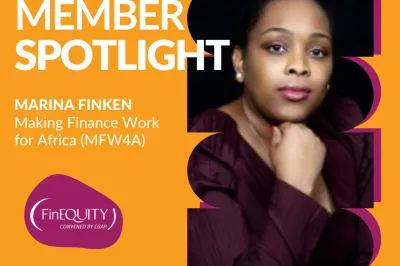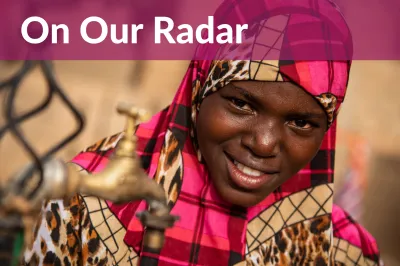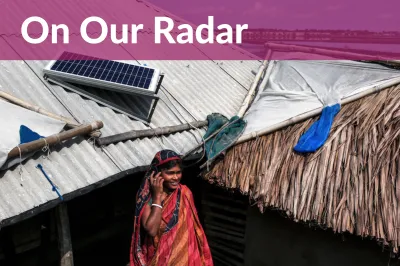How Can Gender Analysis Help Us Understand and Address Women’s Financial Exclusion?

This blog is part of FinEquity's collaboration with USAID on creating resources around gender-balanced workforce, conducting gender analyses and designing women-focused products.
Financial inclusion means that individuals and businesses have access to useful and affordable financial products and services that meet their needs – transactions, payments, savings, credit and insurance – delivered in a responsible and sustainable way, according to the World Bank. In order to increase financial inclusion and thus improve people’s quality of life, the design of products, services, interventions and programs must be rooted in an understanding of why there is a persistent — and in some places growing — gender gap (9% globally) in access and usage that leaves women routinely excluded.
Gender analysis examines the differences in the financial lives, needs and preferences of women and men by asking, “Who does what, how and why? Who has what? Who decides what? How?” and should be a key element of any financial inclusion program or product design. When we pose these questions, we should also be looking at other factors such as age, geography, education and how these intersect with gender identity.
Gender analysis also extends to examining how and why gender constraints exist in the financial market system, such as product features or delivery channels that do not work for women, Know Your Customer (KYC) verification and collateral-related requirements that are harder for women to qualify for or obtain. In addition, not enough financial institutions collect or use sex-disaggregated data, and those entities that do may underuse or not use the data at all when modifying existing products or designing novel ones. Gender analysis also takes into consideration women’s barriers to access and usage of financial services, such as gender norms, time and mobility constrains, and comfort with technology, and assesses how these are met or not met in the design of financial services and programs. Without developing a full picture of what is working and not working for women and why, the goal of financial inclusion cannot be fully realized.
Without developing a full picture of what is working and not working for women and why, the goal of financial inclusion cannot be fully realized.
Gender analysis is not new to financial inclusion, and different stakeholders have been using gender analysis tools and approaches to inform their products, processes, interventions and policies for some time. This may be in the form of customer research using qualitative and quantitative tools to understand the demand for financial services (i.e., research on needs and preferences of specific segments of women and how these are being met (or not met)); or market analysis using primary and secondary data on the supply of financial services to understand what products are available for women, how they are being used or not used, how providers are set up to serve women as clients and how the enabling environment (i.e., policies and infrastructure) facilitate or hinder women’s financial inclusion.
In recent years, amidst a growing recognition of the need for customer centricity in financial inclusion, we’ve seen innovations in the tools and approaches used for both customer research and market analysis. Often based on experience from other sectors, these innovations have the potential to help us better understand the underlying causes of women’s financial exclusion and address them to build a gender-equitable financial system, which is characterized by availability of gender intentional products, a gender-balanced workforce and supported by gender intentional policies. We’ve outlined some examples below that combine different gender analysis tools to better understand the needs of women and design solutions for them.
First things first: understanding how gender norms limit women’s financial inclusion
As noted in the recently published CGAP Technical Guide on addressing gender norms for financial inclusion, These norms are the root cause influencing behavior of all participants in the financial market system, and ultimately result in the exclusion of women.
The 2020 Finscope study for Rwanda found that while the gender gap in access to financial services in Rwanda is relatively small – with 92% of women financially included compared to 93% of men – women in Rwanda are still limited in their ability to use financial services to improve the quality of their own lives as well as that of their households due to prevailing social and gender norms. Access to Finance Rwanda (AFR) found that while women have equal ownership of assets in Rwanda, as a result of gender norms, they’re uncomfortable using these shared assets as collateral to acquire loans for their business. AFR research also found that when financial and business literacy trainings were offered by financial service providers (FSPs) or NGOs, fewer women attended because they were expected to prioritize childcare and household duties.
When designing programs and interventions to advance women’s financial inclusion and economic empowerment, it is critical to start with a gender norms diagnostic. This gives us insights not only into women’s financial lives, needs, preferences, and aspirations, but a deeper understanding of what is driving those preferences, and how gender norms are creating specific constraints for women in the financial market system.
When designing programs and interventions to advance women’s financial inclusion and economic empowerment, it is critical to start with a gender norms diagnostic.
AFR is currently conducting one such gender norms diagnostic and plans to use the insights to design effective norm-informed or norm-transformative interventions that will deepen financial inclusion for women in Rwanda.
Gender analysis to understand constraints faced by specific segments of women
, which are shaped by age, life stage, location and context, among many other factors. In Uganda, Grameen Foundation partnered with GSMA to implement a project to expand digital financial services (DFS) for refugees by providing them with products such as digital wallets and digital savings group loans, with the goal of enhancing their income and resilience opportunities. The project was set in the Bidi Bidi refugee camp in Uganda, one of the largest refugee settlements in the country where the majority of families are female-headed. Given the favorable social and policy environment for refugees in Uganda, many were either already economically active or interested in starting and growing their businesses.
However, the lack of access to finance was a key constraint as FSPs perceived refugees to be transient and not credit worthy. VSLAs filled the financing gap to some extent, but the loan amounts were limited. In addition, many of the female-headed families received regular money transfers from both abroad and humanitarian relief agencies but were unable to access them given the lack of financial access points within or close to the camp. With the proliferation of mobile money in Uganda, the project saw expanding the female agent network as an opportunity to increase overall access to DFS and support entrepreneurship opportunities for women in the camp.
To develop their program strategy, Grameen Foundation conducted a gender analysis using their own framework to understand what factors prevented women from starting and running their own DFS agent businesses, as well as from accessing and using DFS. The Grameen Foundation gender analysis framework looks at entrepreneurship and financial services, time use, mobility, marriage, sexual and gender-based violence (SBGV), assets, education, intersectionality and workplace.
The gender analysis found that refugee women faced significant barriers to access and use of financial services because of gender norms as well as their lack of a social network. Women refugees are expected to manage heavy household workloads and childcare duties, which limit their ability to access financial services from brick-and-mortar financial institutions that are often located far away from refugee settlements. They also face discrimination from FSPs who have limited trust in women’s entrepreneurial abilities, require a husband’s consent for accessing services and hold negative perceptions about women who run businesses (such as assumptions that they are ignoring their household and care responsibilities). Like most women microentrepreneurs, the refugee women microentrepreneurs Grameen Foundation worked with could not meet collateral requirements because they lacked any physical assets (land, machinery, equipment, etc. ) required to secure the necessary start-up capital. They also had limited business management skills.
In response to these constraints, Grameen Foundation worked with three FSPs to develop a tailored strategy for expanding and growing the female agent networks by focusing on providing access to start-up credit for potential agents and providing them with training and support to start and run a business. Having female agents from the refugee settlement allowed the FSPs to expand outreach by onboarding and activating female customers within the camp. For women in the camp, having access to nearby female agents that they knew and trusted allowed them use additional digital financial products including affordable bank loans that were offered through the digitized VSLA.
Gender analysis to support women-centered financial product design
CARE and the Mastercard Center for Inclusive Growths’ Ignite program supports growth-oriented women entrepreneurs in Vietnam, Pakistan and Peru by facilitating access to relevant financial and non-financial products and digital tools, and by addressing normative constraints. To inform the design of the package of support for women entrepreneurs in each of the three program countries, CARE adopted a women-centered design process to understand the needs, barriers and wants of these women.
CARE’s women-centered design process involves working with both women entrepreneurs and FSPs to test, design, launch and iterate product concepts and ideas. The program conducted both qualitative and quantitative research over one year that involved more than 4,000 micro and small women-led businesses. The core themes that the research explored were access to finance, access to business development skills, impacts of COVID-19, financial decision making within the household and digital capabilities. It found that some of the constraints women-led micro and small businesses faced were similar across the three countries - women’s confidence levels, skill-building preferences, time and mobility constraints and familiarity with digital channels – with some variations around the specific terms of the products.
The key to the success of this research effort was adapting the research process to create an environment where women felt comfortable sharing their opinions
The key to the success of this research effort was adapting the research process to create an environment where women felt comfortable sharing their opinions. Women participants decided where to hold the interviews (i.e., business, home, privately) and when (i.e., non-business peak or household care times). In the case of married women, researchers asked for permission to speak to women only. The entire research team was trained in conducting gender-sensitive research and the qualitative and quantitative tools had specific sections and scales on decision making, gender roles, access and control. The use of lean human-centered design tools focused on deep-seated fears, challenges and aspirations helped develop a clearer picture of women’s needs and preferences.
Following these findings, Ignite worked with FSPs and other stakeholders in each of the three countries to create adapted credit products and services for women-led micro and small businesses – all of which are now seeing significant uptake. In Peru, the project focused on larger loans with no credit history (using alternative credit scoring and references), flexible repayment periods and a bundled cancer insurance product. In Vietnam, VPBank created a lower interest rate product and online approval of non-collateralized loans. In Pakistan, UBank offered women entrepreneurs larger loans through a digital platform with digital onboarding and financial education. In addition, Ubank loan officers were trained on how to interact with female clients.
In each of the three countries, CARE designed add-on activities in collaboration with FSPs to address context-specific constraints rooted in gender norms. In Peru, the project designed an app for women to offer financial and digital skills training and a media campaign discussing the role of men in household care responsibilities. In Vietnam, the project launched a campaign celebrating women entrepreneurs’ success and an initiative to support mental and emotional wellbeing sessions for women entrepreneurs. In Pakistan, the project provided digital capability building support and created a campaign on male engagement spotlighting male role models who support women entrepreneurs. The aim was to encourage men to celebrate their wives, daughters and mothers.
Remember: what works for women in terms of financial services design works for men too, but not vice versa
As important as it is to recognize the difference between the financial needs of men and women, it is equally important to remember that women are not a monolith. As the examples in this blog highlight, while there may be some commonalities in the barriers women face, they manifest in different ways depending on additional factors such as age, race, location, education, etc. Gender analysis tools and approaches can help financial inclusion stakeholders develop a better understanding of women’s financial preferences and needs, in-turn designing products, services, processes and policies that meaningfully enhance their lives and livelihoods.
So-called “gender-neutral approaches” that are common in financial inclusion overlook the fact that women and men lead fundamentally different financial lives. It is worth remembering that what works for women in terms of financial services design works for men too, but not vice versa.
In mid-2022, FinEquity will publish a curated set of gender analysis resources intended to provide a starting point for how to better understand common challenges and constraints to women’s financial inclusion and economic empowerment, and how best to address them. Stay tuned!


